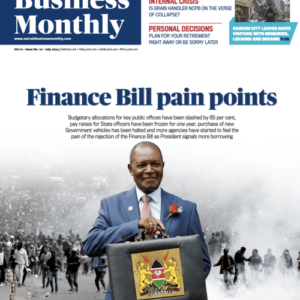BY KEVIN MOTAROKI
The United Nations projects that Africa will have some 1.7 billion people by 2030, and 2.6 billion by 2050. This projected growth poses a real socio-economic challenge because, with its current 1.2 billion people, the continent has perennially fallen short of its food production targets, creating worrying shortages and contributing to the global food crisis.
To plug the deficit and forestall future food shortages, the continent needs to produce at least 80% more food than it currently does – to both guarantee its food needs and to avoid its overreliance on imports, or aid in dire circumstances.
Download Nairobi Business Monthly Latest Edition
Sixty percent – or 600 million hectares – of the world’s uncultivated arable land is found in Africa – this, for a continent that is home to 25% of the world’s active agricultural land but which accounts for just 10% of global production.
As African scholars often hypothesize, and as leaders themselves admit, there is a mismatch between policies and priorities, which leaves the areas that most deserve resources, such as agriculture, underfunded, often in favour of the superfluous. Our planning models are deficient in this regard, at least from a social development perspective.
Happily, with some foresight and goodwill, the continent can shore up its agricultural output to ensure its own food security.
The way to attain this objective is through committed and innovative leadership, which supports and enacts policies that emphasize agricultural transformation. These can then create new pathways that channel funding where it is needed most. At present, the place to begin is with the smallholder farmer.
In his speech at the recent African Green Revolution Forum (AGRF) 2018, Rwanda’s President Paul Kagame hit the nail on the head “We have everything we need to succeed. We must start treating farmers as clients. They need the latest skills and services to increase their productivity,” he said,
Social development scholars – and history – teach us that the way to begin, as with most everything else, is at the bottom, which is where, by design or default, smallholder farmers lie. These are some of the continent’s most hardworking people; ironically, they are also the least advantaged.
Africa has great aspirations for the future. In East Africa, for example, the budget statements of the region’s governments identified food security amongst core priorities, captured in the mantra, “a society that can feed itself can build itself.”
President Kagame’s statement doesn’t just speak to simply empowering small farmers; it also underscores the need to align our priorities to quickly and sustainably deliver incomes to people, guarantee food security and nutrition, as well as deliver associated economic opportunities. In other words, focus on business and progress, while prudent and “normal”, is not enough. Kagame’s wisdom lies in his call to create the capacity to significantly produce more food, and to do it sustainably.
To consider farmers as clients – as opposed to beneficiaries of aid, for example – is to employ a market-based model that offers a comprehensive bundle of services, which provide a value chain that helps and uplifts them at every stage. It is also recognition that we cannot simplify the problem of rural poverty, or hope for a one-fits-all solution.
It is a model that some aid organizations have tried and implemented with more than appreciable success. The schematic is simple enough: employing a multipronged approach that includes the provision of high-quality planting material (seed and fertiliser) on credit, which are delivered to within walking distance of clients – the farmers. The organisations provide training, which is carried out throughout the season, as well as offer market facilitation. By proffering training on the latest and best farming practices, they guarantee – climate permitting – good yields. And by providing market facilitation, which includes storage and knowledge on market fluctuations, farmers can maximise profits. This is necessarily good for every stakeholder.
The beauty of this model is in its simplicity, which means it can be replicated anywhere.
As Kagame covertly suggests, modern skills are not to be hogged for and by those with plantation or industrial capacity, for there is better and more profound benefit in sharing them with the people who carry our societies on their backs.
Kenya’s President Uhuru Kenyatta lists food security among his four economic pillars. Uganda’s Museveni and Tanzania’s Magufuli, and Kagame himself, have socio-economic wellbeing at the core of their development schemas. What is more, every government in sub-Saharan Africa has food production at the top of its priorities.
The saying, which cannot be repeated too often, goes that if we want to prosper, we must be able to feed ourselves. In our local scenarios, hard-working farmers are at the heart of rural development and national prosperity, which is why Kagame’s assertion is an idea every government and head of state must champion.
The writer is The Nairobi Law Monthly magazine Managing Editor


